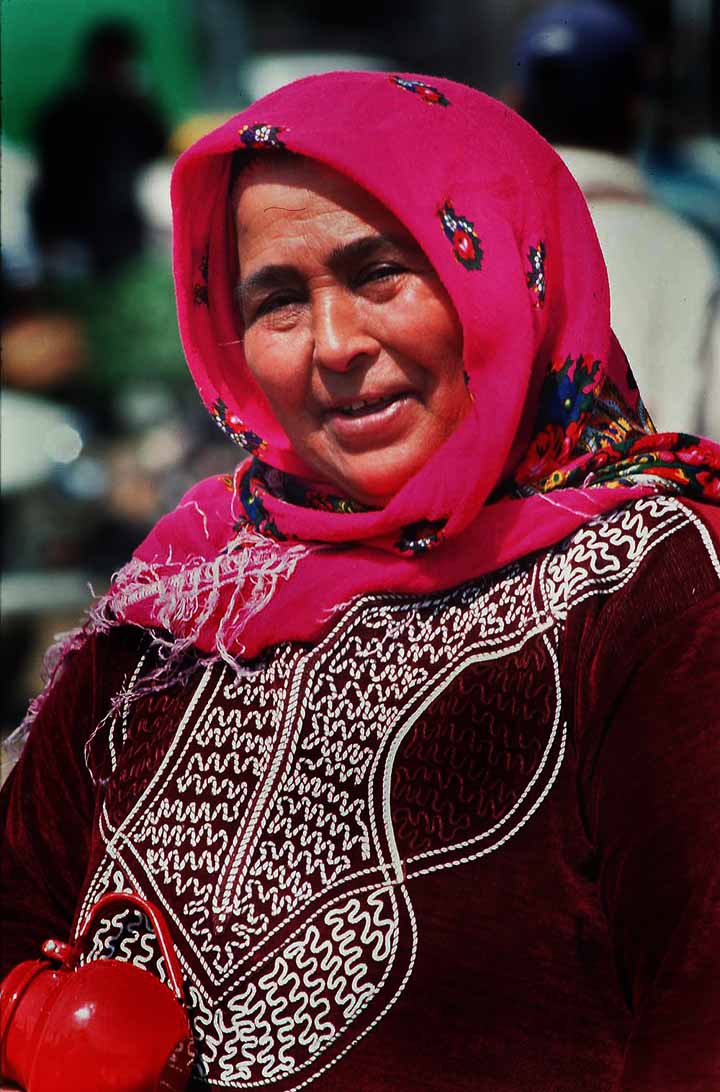
Hijab
In modern usage, hijab (Arabic: حجاب, romanized: ḥijāb, pronounced [ħɪˈdʒaːb]) generally refers to various head coverings conventionally worn by many Muslim women.[1][2] It is similar to the tichel or snood worn by Orthodox Jewish women, certain headcoverings worn by some Christian women, such as the mantilla, apostolnik and wimple,[3][4] and the dupatta worn by many Hindu and Sikh women.[5][6][7] Whilst a hijab can come in many forms, it often specifically refers to a scarf wrapped around the head, covering the hair, neck and ears but leaving the face visible.[8][9] The use of the hijab has been on the rise worldwide since the 1970s and is viewed by many Muslims as expressing modesty and faith; it has also been worn for purposes of adornment.[8][10] When it comes to the obligation for a Muslim woman to cover her hair and body, many have expressed confusion about the origin of this commandment. However, there has never been any debate within Sunni Islamic scholarship at any point in history regarding the obligation of hijab for all Muslim women who have reached the age of puberty.[11][12]
The term ḥijāb was originally used to denote a partition or a curtain and was sometimes used for Islamic rules of modesty.[8][13] This is the usage in the verses of the Qur'an, in which the term sometimes refers to a curtain separating visitors to Muhammad's main house from his wives' lodgings. This has led some to claim that the mandate of the Qur'an applied only to the wives of Muhammad and not to all women.[14][15] Another interpretation can also refer to the seclusion of women from men in the public sphere, whereas a metaphysical dimension may refer to "the veil which separates man, or the world, from God".[16] The Qur'an never uses the word hijab to refer to women's clothing, but passages discuss the attire of women using other terms jilbab and khimār.[17] For some the term for headscarf in the Qur'an is khimār (Arabic: خِمار).[8][18][13][19][20]
There is no consensus over how much of a veil is a necessity. Some legal systems accept the hijab as an order to cover everything except the face and hands,[21][16] whilst others accept it as an order to cover the whole body, including the face and hands.[22] These guidelines are found in texts of hadith and fiqh developed after the revelation of the Qur'an. Some believe these are derived from the verses (ayahs) referring to hijab in the Qur'an;[23] others believe that the Qur'an does not mandate that women need to wear a hijab.[24][25] Some reformist groups consider the issue of veiling in Islam as only a recommendation made according to the conditions of the past and that regarding it as a necessity is an imposition of Islamist ideology.[24][25]
The practice of Islamic veiling varies around the world according to local laws and customs. The hijab is currently required by law to be worn by women in Iran[26] and in Afghanistan by the Taliban government.[27] Since 2018 it has no longer been required by law in Saudi Arabia.[28][29][30] Other countries, both in Europe and in the Muslim world,[31] have passed laws banning some or all types of hijab in public or in certain types of locales.[32][33][34] Women in different parts of the world have also experienced unofficial pressure to wear or not wear a hijab.[33][34]
In Islamic scripture[edit]
Qur'an[edit]
Qur'anic verses relating to dress codes use the terms khimār which translates to “veil” in English, (but, according to some, a headcovering[37][38]) and jilbāb (a dress or cloak) rather than ḥijāb.[13][nb 1] About six verses refer specifically to the way a woman should dress and walk in public;[39] Muslim scholars have differed as to how these verses should be applied, with some stating that a headscarf is required and others saying that a headscarf is not required.[40]
The clearest verses on the requirement of modest dress are Surah 24:30–31, telling both men and women to dress and act modestly, with more detail about modest dress focused on women.[41][42]